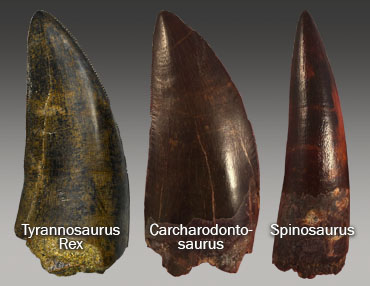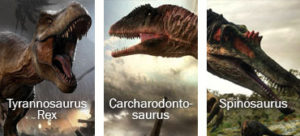
Tyrannosaurus rex Tooth
Carcharodontosaurus Tooth
Spinosaurus Tooth
North Dakota/Morocco
7.5 cm./8 cm./7.5 cm.
Most theropods, the dinosaurs that bite, possessed sharp teeth with serrated edges. The shape of their teeth was indicative of how and what they ate. Heavy, oval-shaped teeth were ideal for crushing, knife-shaped teeth were for slicing, and long, round teeth were effective at spearing.
Let’s look at the teeth of three well-known carnivores, the Tyrannosaurus rex, Carcharodontosaurus, and Spinosaurus.
The T. rex was a powerful predator, 40 feet long, with a solid head and lower jaw. Its teeth were large and banana-shaped. These were built to withstand tremendous pressure, likely to take down large prey and feed on the entire carcass, rather than just the soft areas. These were long, crushing teeth, paired with massive jaws.

40 million years earlier roamed the Carcharodontosaurus, the T. rex of its day. Its size was comparable to the Tyrannosaurus, though its skull was of weaker construction. Teeth of the Carcharodontosaurus were thinner and more blade-like. Their shape was better suited to slicing chucks of flesh, similar to how sharks feed. Its hunting technique may have been to bite its running prey to administer a severe wound. The weakened animal would eventually collapse from blood loss. The Carcharodontosaurus could then feed without a struggle.
Sharing the land with the Carcharodontosaurus was the Spinosaurus. It was the largest of all theropods with a length of 50 feet. Its enormous sail arching over its back and a head similar to that of a giant crocodile was likely a frightening sight. Its teeth were round and sharply pointed. These were more capable of spearing and shredding food rather than aggressively pursuing dinner. Fish was likely the food of choice for the Spinosaurus, based not only on its teeth but also its long snout.
The T. Rex specimen was acquired by the museum from a private party in Los Angeles. It has since been sold at auction. The Carcharodontosaurus an Spinosaurus specimens were recently acquired from Buried Treasure Fossils of Richmond, Texas.